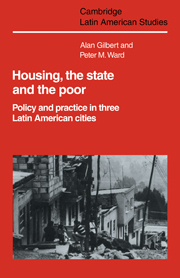Book contents
- Frontmatter
- Contents
- List of figures
- List of tables
- Acknowledgements
- Abbreviations
- 1 Introduction: the research issues and strategy
- 2 Bogotá, Mexico City and Valencia: the social, economic and political backcloth
- 3 Access to land
- 4 Servicing low-income settlements
- 5 Community organization: participation or social control?
- 6 Conclusions
- Appendix 1 The methodology in detail
- Appendix 2 Description of the survey settlements
- Notes
- Bibliography
- Author index
- Subject index
- CAMBRIDGE LATIN AMERICAN STUDIES
3 - Access to land
Published online by Cambridge University Press: 04 August 2010
- Frontmatter
- Contents
- List of figures
- List of tables
- Acknowledgements
- Abbreviations
- 1 Introduction: the research issues and strategy
- 2 Bogotá, Mexico City and Valencia: the social, economic and political backcloth
- 3 Access to land
- 4 Servicing low-income settlements
- 5 Community organization: participation or social control?
- 6 Conclusions
- Appendix 1 The methodology in detail
- Appendix 2 Description of the survey settlements
- Notes
- Bibliography
- Author index
- Subject index
- CAMBRIDGE LATIN AMERICAN STUDIES
Summary
As earlier chapters have demonstrated, one of the key issues which determines the opportunity for self-help consolidation in housing is the availability of land. Where land is accessible to the poor and tenure is guaranteed in law or in practice, home improvements will usually take place. In none of our three cities is land freely available. To obtain land, even poorly located land, is a struggle in each city. The purpose of this chapter is broadly to explain how the process of land acquisition takes place and to explain the differences and implications of allocation mechanisms in each city.
First, we examine how land is allocated to the poor as a group in society. What are the mechanisms by which the poor receive the ‘worst’ land and the more powerful and affluent classes receive the more desirable areas? Specifically, we consider the relationship between the coventional market for land, and its associated construction industry, and the low-income land market. In considering this relationship we must perforce examine the ways in which the state arbitrates and intervenes in the necessarily competitive process of land allocation.
Second, we examine in more detail the overt and covert intervention of the state in the process of land allocation. What is the purpose of residential zoning, building standards and urban perimeters, and how do they affect the market for land?
- Type
- Chapter
- Information
- Housing, the State and the PoorPolicy and Practice in Three Latin American Cities, pp. 61 - 129Publisher: Cambridge University PressPrint publication year: 1985

